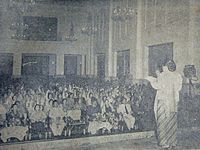Gerwani
 |
|
| Full name | Gerakan Wanita Indonesia (Indonesian Women's Movement) |
|---|---|
| Founded | June 1950 |
| Date dissolved | 1965 |
| Members | 1.5 million (1963) |
| Affiliation | PKI |
| Country | Indonesia |
Gerwani (Gerakan Wanita Indonesia, or Indonesian Women's Movement) was a women's organization founded as Gerwis (Gerakan Wanita Indonesia Sedar, or Movement of Conscious Indonesian Women) in Semarang on 4 June 1950.
In 1954, Gerwis as an activist-based movement changed its name to Gerwani to signify its move towards a mass organization to appeal to communist supporters. Beginning with only 500 members in 1950, Gerwani claimed to have 1.5 million members in 1963. As one of the largest women’s organizations in the 1950s, its broad membership was also a product of its close affiliation with the Partai Komunis Indonesia (PKI, or Communist Party of Indonesia) – reflected in Gerwani’s concerns particularly with helping poor women workers, as well as their alliances with various labor unions. Nonetheless, Gerwani was an independent organization with both a feminist, and PKI-led wing. By 1965, Gerwani claimed to have 3 million members.
Under Sukarno’s Guided Democracy beginning in 1958, Gerwani’s advocacy for gender equality, equal labor rights, and women’s issues began to shift towards one more adherent with PKI and Sukarno’s interests. Gerwani’s priority by the 1960s was no longer feminism, but anti-imperialism and the “national unity of women to liquidate the remains of colonialism and feudalism.” Founding members such as S.K Trimurti, eventually left Gerwani after becoming disillusioned with the trajectory of Gerwani’s political involvement.
Gerwani’s affiliation with the Partai Komunis Indonesia (PKI) eventually led to their demise after the events of Gerakan 30 September, G30S and the “attempted” coup. The arrest and imprisonment of Gerwani members was justified by the fabricated involvement of Gerwani in the killings of the six Generals during G30S. The Lubang Buaya myth, as described as discussed by historians, claimed that Gerwani had performed sadistic, sexual crimes before and after killing the six Generals during G30S. More seriously, Lubang Buaya was used to justify the mass killings of communists in the period immediately after the G30S – an incident that also led to the demise of Gerwani.
The memorialization of the Lubang Buaya myth continues to be represented in the Monument of the Sacred Pancasila at the Lubang Buaya site today.
See also: Sukarno, Nahdlatul Ulama, Parliamentary democracy, Guided Democracy in Indonesia
...
Wikipedia
